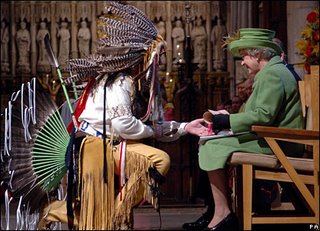
Native American honoured by Queen
The Queen is handed a copy of the original 18th century petitionThe Queen was given a peace pipe at a memorial to a Native American chieftain to symbolise the righting of a wrong.
Accompanied by the Duke of Edinburgh, she paid her respects to Mahomet Weyonomon, of the Mohegan tribe, who died of smallpox in London in 1736.
Tribal leaders in traditional regalia blessed a memorial stone in his honour.
Mahomet had travelled from Connecticut to petition George II about the capture of his tribe's land by English settlers but died before he met the king.
Foreigners were barred from being buried in the City of London so his body was interred in an unmarked grave.
'Proper burial'
The Queen and the duke were joined by tribal spiritual leader Bruce "Two Dogs" Bozsum and other Mohegans wearing deerskin leggings and headdresses made with turkey and eagle feathers at the memorial ceremony at Southwark Cathedral on Wednesday.
She was presented with a scroll containing a copy of the original petition and a red stone peace pipe.
Mr Bozsum said: "We are glad that we have given him a proper burial now.
We cannot right past wrongs but we can remember them and transform them
Very Rev Colin Slee, Dean of Southwark"The Queen said she was very pleased , very honoured to see us and have us here. It meant a lot to us. This is the highlight of my life to meet the Queen."
The Very Rev Colin Slee, Dean of Southwark, gave an address about the significance of the events.
He said: "We are here to dedicate a memorial, to complete an unfinished commission, to remember we share with the people of the United States a story which, like all human conduct, is marked by good and bad.
"We cannot right past wrongs but we can remember them and transform them to inspire better conduct throughout humanity now and in years to come."
The Queen also unveiled a stone sculpture, carved by Peter Randall Page, which stands in the south churchyard.
The five-tonne piece of pink granite came from the tribal reserve in New England. It is customary to name a boulder after a chief who has died.
No comments:
Post a Comment